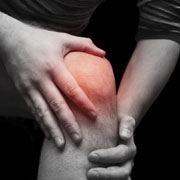LEARN ABOUT THE DYNAMICS OF APPLIED BIOMECHANICSAND AND UNDERSTAND YOUR PAIN:
Knee pain is typically caused by wear and tear or trauma. Examples include athletic injuries, such as an ACL tear, or repetitive overuse activities like stair climbing or running that may lead to knee pain. The knee is subject to ongoing shearing forces, and slow, steady deterioration of the structures in the knee joint is often the result of medial collapse. This concept is supported by extensive research from Dr. Chris Powers at the University of California, who was the first to demonstrate how the femur rotates under the patella using active MRI. (For more, visit: Movement PI – Dr. Chris Powers).

Our knee pain treatment plans and diagnoses are grounded in the biomechanical research of Christopher M. Powers, PhD, PT, FACSM, FAPTA, at the University of California. Key concepts include ‘glute strategy,’ ‘quad dominance,’ and ‘trunk posture compensation.
Understanding the development of knee pain depends on the specific structure involved, such as patellofemoral pain or internal derangement. In many cases, biomechanical issues, particularly weakness in the gluteal muscles, are contributing factors. This weakness results from poor activation of the gluteal mechanisms, which are crucial for stabilizing the knee during movement. By identifying the specific structure and its symptoms, we can create powerful, effective exercise plans. Rehabilitation should focus on hip strengthening and teaching proper movement patterns.
LEARN HOW OUR OFFICE CAN HELP YOUR INJURY AND PREVENT FUTURE KNEE ISSUES:
We evaluate patients by assessing their movement patterns and biomechanical weaknesses. This is done through manual and active testing, along with video analysis of walking and/or running. We analyze the movement at each phase of gait to identify where deviations occur and how to correct them. We measure ground reaction forces and shock absorption during activities like running, walking, jumping, cutting, and stair climbing. Only after this thorough assessment can we pinpoint the areas that need correction to reduce pain. These corrections are achieved through strength, flexibility, and movement retraining exercises. There are seven levels for restoration, each with specific performance and progression parameters. For sports-related issues, we have a detailed return-to-sport protocol, as well as protocols for daily activities. Mastering these protocols is key to preventing future injuries.
In many cases, understanding and treating the fascial binding of the foot, leg, and hip is crucial for addressing knee pain. Fascia treatment helps improve the biomechanical relationship between the foot, knee, and pelvis, thereby reducing knee pain. There is a specific fascial structure that runs along the peroneal group, loops under the base of the calcaneus, ascends through the tibialis anterior, and spirals up the iliotibial band and biceps femoris. This fascial network plays a dynamic role in foot placement and pelvic rotation. By focusing on this structure, in combination with addressing biomechanical dysfunctions, significant improvements in movement and pain relief can be achieved.
